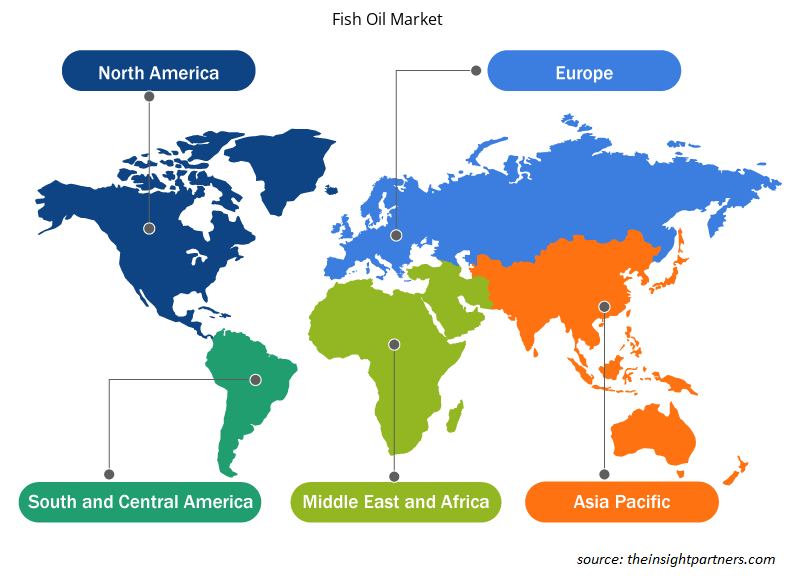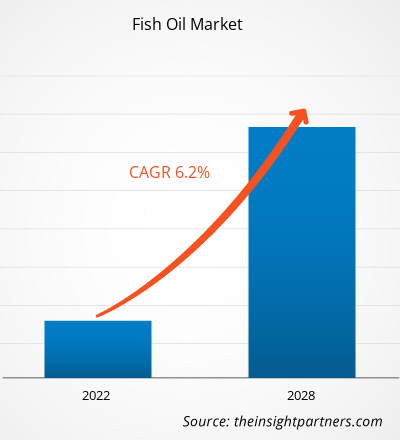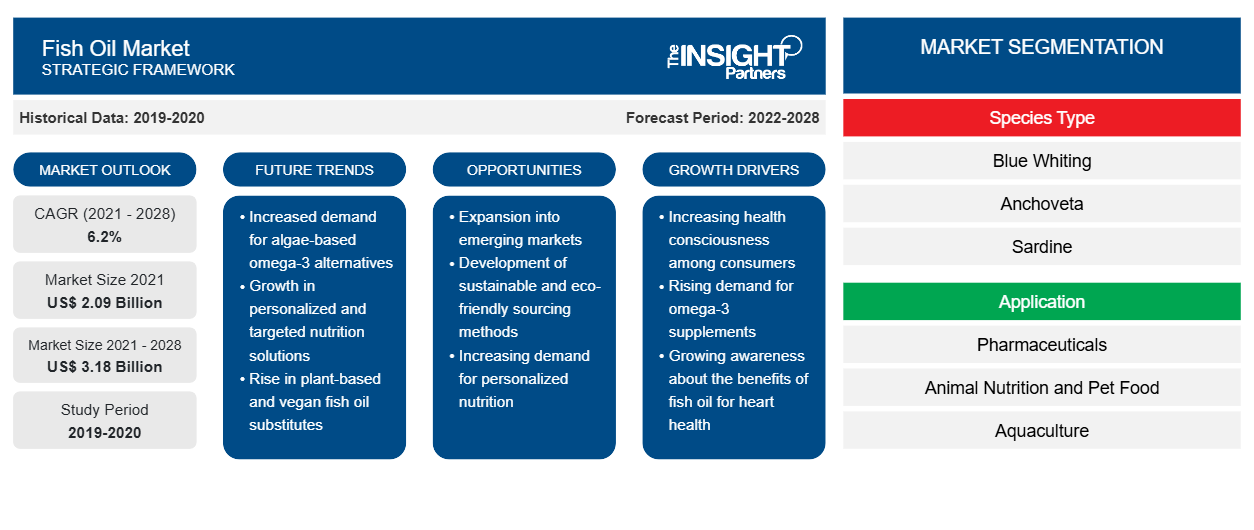El mercado de aceite de pescado se valoró en 2.087,39 millones de dólares en 2021 y se proyecta que alcance los 3.178,28 millones de dólares en 2028. Se espera que crezca a una CAGR del 6,2% entre 2021 y 2028.
El aceite de pescado se obtiene de los tejidos de varias especies de peces e incluye ácidos grasos omega-3, como los ácidos eicosapentaenoicos (EPA) y docosahexaenoicos (DHA). Estos proporcionan diversos beneficios para la salud, como la reducción del riesgo de muerte por ataque cardíaco, ritmos cardíacos anormales peligrosos, niveles más bajos de triglicéridos y accidentes cerebrovasculares.
En 2020, Asia Pacífico dominó el mercado mundial de aceite de pescado y se espera que mantenga su dominio durante el período de pronóstico. La creciente conciencia relacionada con los beneficios para la salud y el rico perfil nutricional del aceite de pescado está impulsando el crecimiento del mercado de aceite de pescado en toda la región. Junto con esto, la mayor prevalencia de enfermedades crónicas en varios países de la región está generando una mayor demanda de aceite de pescado. Por ejemplo, en Australia, se estima que el cincuenta por ciento de los australianos padecen al menos 1 de las 8 enfermedades crónicas comunes seleccionadas: cáncer, enfermedad cardiovascular, problemas de salud mental, artritis, dolor y problemas de espalda, enfermedad pulmonar obstructiva crónica, asma y diabetes. Se espera que estos factores ayuden al crecimiento de la demanda de aceite de pescado en toda la región.
Personalice este informe según sus necesidades
Obtendrá personalización en cualquier informe, sin cargo, incluidas partes de este informe o análisis a nivel de país, paquete de datos de Excel, así como también grandes ofertas y descuentos para empresas emergentes y universidades.
-
Obtenga las principales tendencias clave del mercado de este informe.Esta muestra GRATUITA incluirá análisis de datos, desde tendencias del mercado hasta estimaciones y pronósticos.
Perspectivas del mercado
Amplia gama de aplicaciones del aceite de pescado en diferentes industrias
El aceite de pescado se utiliza cada vez más en diversas industrias, como la farmacéutica, los suplementos dietéticos , la nutrición animal y la comida para mascotas . Encuentra una aplicación importante en la industria farmacéutica y se considera aceite natural o concentrados de EPA-DHA. También se utiliza para la alimentación animal, ya que proporciona efectos promotores del crecimiento y es una fuente de energía económica. Aparte de esto, también se utiliza en la comida para mascotas y ayuda a fortalecer el sistema inmunológico de los perros, al tiempo que ayuda a combatir el cáncer canino. El aceite de pescado también se utiliza como suplemento dietético, donde las cápsulas se elaboran tradicionalmente utilizando gelatina que cubre el aceite en las cápsulas de gel blando. Por lo tanto, el uso de aceite de pescado en diferentes industrias está impulsando el crecimiento del mercado del aceite de pescado.
Información sobre los tipos de especies
Según el tipo de especie, el mercado del aceite de pescado se divide en bacaladilla, anchoveta, sardina, capelán y otros. En 2020, el segmento de la sardina fue el de mayor crecimiento en el mercado. La sardina es un pez pequeño parecido al arenque con diversos beneficios nutricionales similares a los de otros peces como el salmón. El aceite extraído de la sardina también se utiliza como lubricante y se utiliza principalmente en pinturas, barnices, biocombustibles y linóleo.
Pesquera Exalmar SAA; Omega Protein Corporation; Pelagia AS; Copeinca; Coplex International SAC; Triplenine; FF Skagen A/S; DSM; Croda International PLC; y BASF SE son los actores clave que operan en el mercado del aceite de pescado. Los principales actores adoptan varias estrategias, como fusiones y adquisiciones y lanzamientos de productos, para expandir su presencia geográfica y su base de consumidores.
Informe Destacado
- Tendencias progresivas en la industria del aceite de pescado para ayudar a los actores a desarrollar estrategias efectivas a largo plazo
- Estrategias de crecimiento empresarial adoptadas por las empresas para asegurar el crecimiento en los mercados desarrollados y en desarrollo
- Análisis cuantitativo del mercado mundial de aceite de pescado de 2019 a 2028
- Estimación de la demanda de aceite de pescado en diversas industrias
- Análisis de Porter para ilustrar la eficacia de los compradores y proveedores que operan en la industria para predecir el crecimiento del mercado
- Desarrollos recientes para comprender el escenario competitivo del mercado y la demanda del aceite de pescado
- Tendencias y perspectivas del mercado junto con los factores que impulsan y restringen el crecimiento del mercado de aceite de pescado
- Comprensión de las estrategias que sustentan el interés comercial con respecto al crecimiento del mercado mundial de aceite de pescado, ayudando en el proceso de toma de decisiones.
- Tamaño del mercado de aceite de pescado en varios nodos del mercado
- Descripción detallada y segmentación del mercado mundial de aceite de pescado, así como su dinámica industrial.
- Tamaño del mercado de aceite de pescado en varias regiones con oportunidades de crecimiento prometedoras
Perspectivas regionales del mercado del aceite de pescado
Los analistas de Insight Partners explicaron en detalle las tendencias y los factores regionales que influyen en el mercado de aceite de pescado durante el período de pronóstico. Esta sección también analiza los segmentos y la geografía del mercado de aceite de pescado en América del Norte, Europa, Asia Pacífico, Oriente Medio y África, y América del Sur y Central.

- Obtenga datos regionales específicos para el mercado de aceite de pescado
Alcance del informe sobre el mercado del aceite de pescado
| Atributo del informe | Detalles |
|---|---|
| Tamaño del mercado en 2021 | US$ 2.09 mil millones |
| Tamaño del mercado en 2028 | US$ 3.18 mil millones |
| CAGR global (2021-2028) | 6,2% |
| Datos históricos | 2019-2020 |
| Período de pronóstico | 2022-2028 |
| Segmentos cubiertos |
Por tipo de especie
|
| Regiones y países cubiertos |
América del norte
|
| Líderes del mercado y perfiles de empresas clave |
|
Densidad de actores del mercado de aceite de pescado: comprensión de su impacto en la dinámica empresarial
El mercado del aceite de pescado está creciendo rápidamente, impulsado por la creciente demanda de los usuarios finales debido a factores como la evolución de las preferencias de los consumidores, los avances tecnológicos y una mayor conciencia de los beneficios del producto. A medida que aumenta la demanda, las empresas amplían sus ofertas, innovan para satisfacer las necesidades de los consumidores y aprovechan las tendencias emergentes, lo que impulsa aún más el crecimiento del mercado.
La densidad de actores del mercado se refiere a la distribución de las empresas o firmas que operan dentro de un mercado o industria en particular. Indica cuántos competidores (actores del mercado) están presentes en un espacio de mercado determinado en relación con su tamaño o valor total de mercado.
Las principales empresas que operan en el mercado de aceite de pescado son:
- PESQUERA EXALMAR SAA
- CORPORACIÓN DE PROTEÍNAS OMEGA
- PELAGIA COMO
- COPEANCA
- COPLEX INTERNACIONAL SAC
Descargo de responsabilidad : Las empresas enumeradas anteriormente no están clasificadas en ningún orden particular.

- Obtenga una descripción general de los principales actores clave del mercado de aceite de pescado
El "Análisis del mercado mundial de aceite de pescado hasta 2028" es un estudio especializado y profundo de la industria de alimentos y bebidas con un enfoque especial en el análisis de tendencias del mercado mundial de aceite de pescado. El informe tiene como objetivo proporcionar una descripción general del mercado con una segmentación detallada del mercado. El mercado de aceite de pescado se analiza en tres frentes: tipo de especie, aplicación y geografía. Según el tipo de especie, el mercado se bifurca en bacaladilla, anchoveta, sardina, capelán y otros. Según la aplicación, el mercado de aceite de pescado se bifurca en productos farmacéuticos, nutrición animal y alimentos para mascotas, acuicultura, suplementos dietéticos y otros. Según la geografía, el mercado de aceite de pescado está segmentado en cinco regiones principales: América del Norte, Europa, Asia-Pacífico, Oriente Medio y África, y América del Sur y Central.
Perfiles de empresas
- BASF SE
- Copeinca
- Coplex Internacional SAC
- Croda Internacional PLC
- DSM
- FF Skagen A/S
- Corporación de Proteínas Omega
- Pelagia AS
- Pesquera Exalmar SAA
- Triple nueve
- Análisis histórico (2 años), año base, pronóstico (7 años) con CAGR
- Análisis PEST y FODA
- Tamaño del mercado, valor/volumen: global, regional y nacional
- Industria y panorama competitivo
- Conjunto de datos de Excel
Informes recientes
Informes relacionados
Testimonios
Razón para comprar
- Toma de decisiones informada
- Comprensión de la dinámica del mercado
- Análisis competitivo
- Información sobre clientes
- Pronósticos del mercado
- Mitigación de riesgos
- Planificación estratégica
- Justificación de la inversión
- Identificación de mercados emergentes
- Mejora de las estrategias de marketing
- Impulso de la eficiencia operativa
- Alineación con las tendencias regulatorias























 Obtenga una muestra gratuita para - Mercado de aceite de pescado
Obtenga una muestra gratuita para - Mercado de aceite de pescado